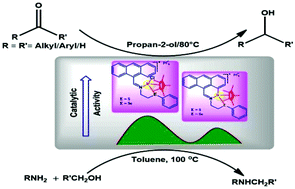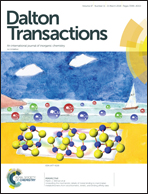Base free N-alkylation of anilines with ArCH2OH and transfer hydrogenation of aldehydes/ketones catalyzed by the complexes of η5-Cp*Ir(iii) with chalcogenated Schiff bases of anthracene-9-carbaldehyde†
Abstract
The condensation of anthracene-9-carbaldehyde with 2-(phenylthio/seleno)ethylamine results in Schiff bases [PhS(CH2)2C![[double bond, length as m-dash]](https://www.rsc.org/images/entities/char_e001.gif) N-9-C14H9](L1) and [PhSe(CH2)2C
N-9-C14H9](L1) and [PhSe(CH2)2C![[double bond, length as m-dash]](https://www.rsc.org/images/entities/char_e001.gif) N-9-C14H9] (L2). On their reaction with [(η5-Cp*)IrCl(μ-Cl)]2 and CH3COONa at 50 °C followed by treatment with NH4PF6, iridacycles, [(η5-Cp*)Ir(L-H)][PF6] (1: L = L1; 2: L = L2), result. The same reaction in the absence of CH3COONa gives complexes [(η5-Cp*)Ir(L)Cl][PF6] (3–4) in which L = L1(3)/L2(4) ligates in a bidentate mode. The ligands and complexes were authenticated with HR-MS and NMR spectra [1H, 13C{1H} and 77Se{1H} (in the case of L2 and its complexes only)]. Single crystal structures of L2 and half sandwich complexes 1–4 were established with X-ray crystallography. Three coordination sites of Ir in each complex are covered with η5-Cp* and on the remaining three, donor atoms present are: N, S/Se and C−/Cl−, resulting in a piano-stool structure. The moisture and air insensitive 1–4 act as efficient catalysts under mild conditions for base free N-alkylation of amines with benzyl alcohols and transfer hydrogenation (TH) of aldehydes/ketones. The optimum loading of 1–4 as a catalyst is 0.1–0.5 mol% for both the activations. The best reaction temperature is 80 °C for transfer hydrogenation and 100 °C for N-alkylation. The mercury poisoning test supports a homogeneous pathway for both the reactions catalyzed by 1–4. The two catalytic processes are most efficient with 3 followed by 4 > 1 > 2. The mechanism proposed on the basis of HR-MS of the reaction mixtures of the two catalytic processes taken after 1–2 h involves the formation of an alkoxy and hydrido species. The real catalytic species proposed in the case of iridacycles results due to the loss of the Cp* ring.
N-9-C14H9] (L2). On their reaction with [(η5-Cp*)IrCl(μ-Cl)]2 and CH3COONa at 50 °C followed by treatment with NH4PF6, iridacycles, [(η5-Cp*)Ir(L-H)][PF6] (1: L = L1; 2: L = L2), result. The same reaction in the absence of CH3COONa gives complexes [(η5-Cp*)Ir(L)Cl][PF6] (3–4) in which L = L1(3)/L2(4) ligates in a bidentate mode. The ligands and complexes were authenticated with HR-MS and NMR spectra [1H, 13C{1H} and 77Se{1H} (in the case of L2 and its complexes only)]. Single crystal structures of L2 and half sandwich complexes 1–4 were established with X-ray crystallography. Three coordination sites of Ir in each complex are covered with η5-Cp* and on the remaining three, donor atoms present are: N, S/Se and C−/Cl−, resulting in a piano-stool structure. The moisture and air insensitive 1–4 act as efficient catalysts under mild conditions for base free N-alkylation of amines with benzyl alcohols and transfer hydrogenation (TH) of aldehydes/ketones. The optimum loading of 1–4 as a catalyst is 0.1–0.5 mol% for both the activations. The best reaction temperature is 80 °C for transfer hydrogenation and 100 °C for N-alkylation. The mercury poisoning test supports a homogeneous pathway for both the reactions catalyzed by 1–4. The two catalytic processes are most efficient with 3 followed by 4 > 1 > 2. The mechanism proposed on the basis of HR-MS of the reaction mixtures of the two catalytic processes taken after 1–2 h involves the formation of an alkoxy and hydrido species. The real catalytic species proposed in the case of iridacycles results due to the loss of the Cp* ring.



 Please wait while we load your content...
Please wait while we load your content...